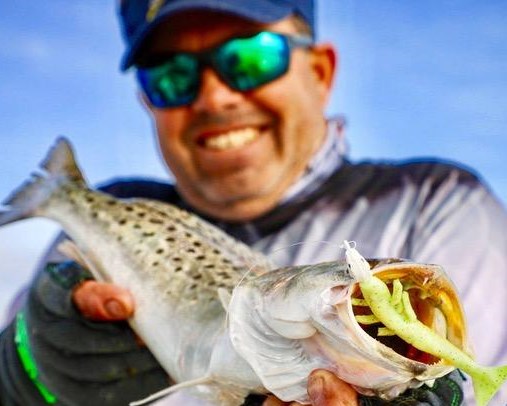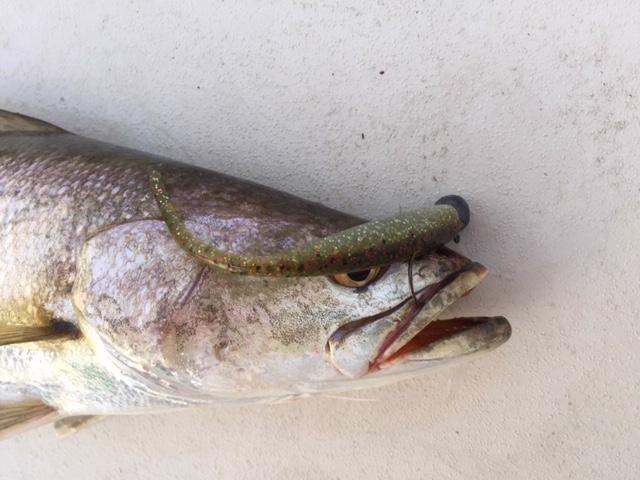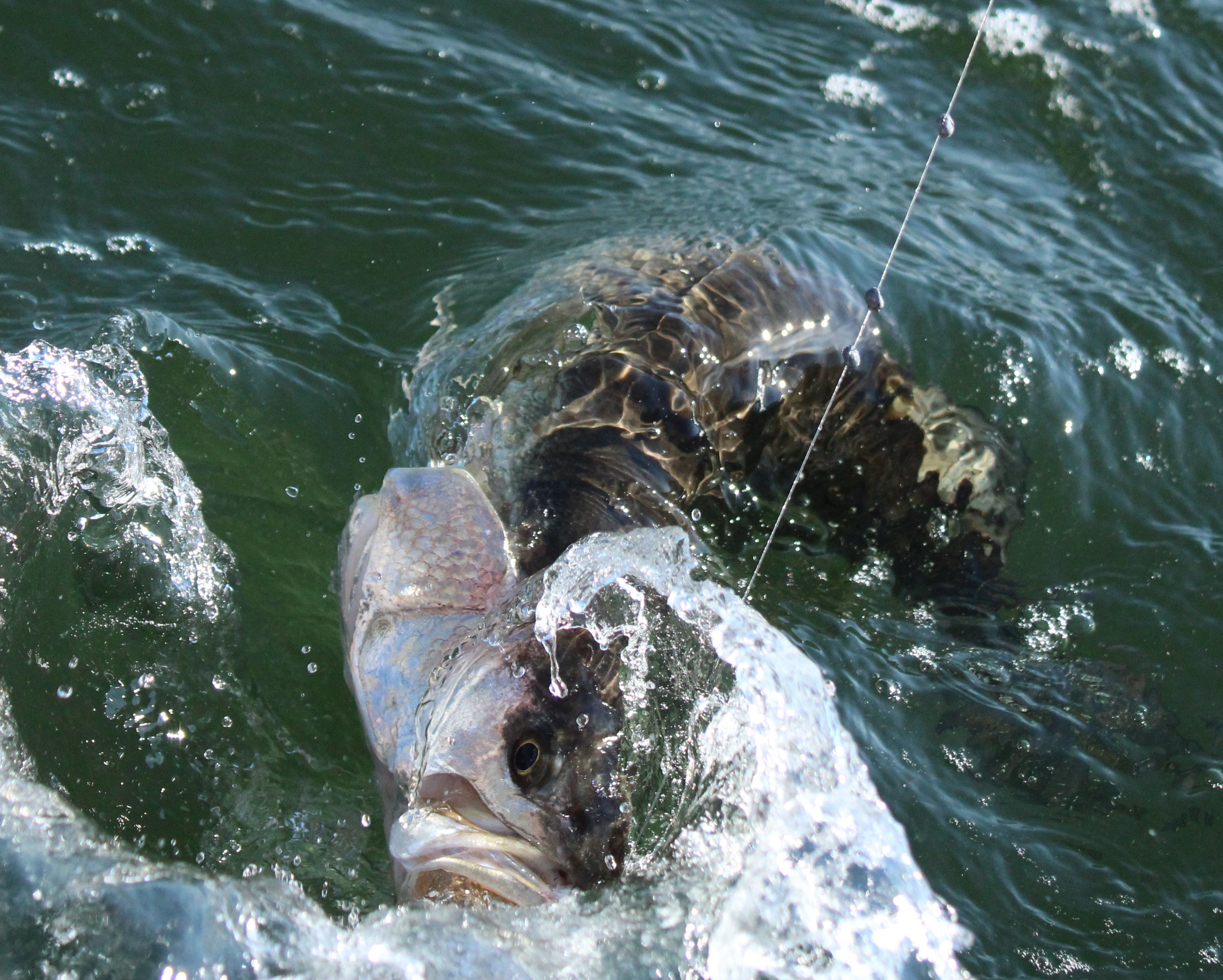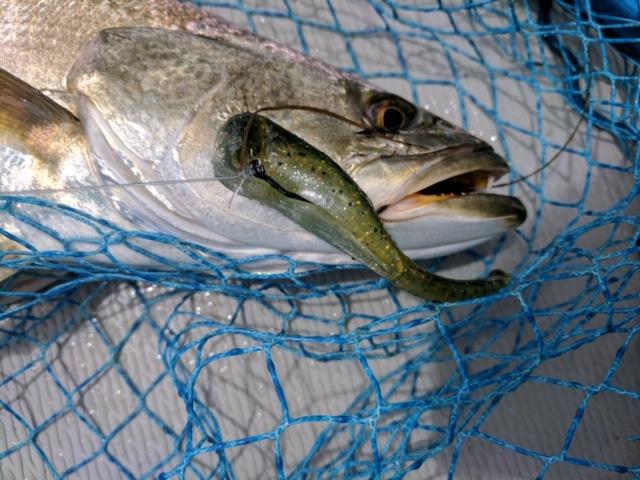When selecting the best speckled trout rig for fall fishing, I like to use three types of artificial lures. We will start from the bottom of the water column and work our way to the top.
Jigs
I catch a ton of fish on jigs in the fall, I think mainly due to all the shrimp in our system at this time of year. Each year in the late summer to early fall all the white shrimp in Mobile Bay migrate into the Upper Mobile Bay, Mobile-Tensaw Delta and tidal rivers. The trout and redfish are usually right behind them following this bio-mass of shrimp.
I have become very partial to a newer lure that Pure Flats LLC has been making called the Lil Slick. My favorite three colors at the moment are Cool Beans, Limon, and Pink Passion.
Another line of lures that I have been using a lot on speckled trout rig for fall fishing is the new line of Fish Bites soft plastics called Fight Club. They are scent infused lures that I think trigger bites sometimes when fish are a little finicky. I like to use a braided main line of about 20-30 pound test line attached to a 3-5 foot section of 20 lb fluorocarbon leader with an improved albright knot. As for the jig head I exclusively use a 1/8, 1/4, or 3/8 ounce 4/0 hook size Hogie lead jig head.

I do not think the color of the jig head matters. I have been using the plain lead colored heads for half a lifetime with very favorable results. I like the Hogie jig heads because they have a very strong sharp wide gap hook and also they have a screw lock to hold the Lil Slick up against the lead head. On a traditional style jighead they usually have a point that sticks out on the hook to hold up the plastic and after catching a few fish the plastic will want to slide down and fall off the hook. The screw lock holds it in place very securely.
I am also very adamant about using a loop knot to attach the jig to my 20lbs fluorocarbon and my speckled trout rigs for fall. I like the non-slip loop knot developed by the late Lefty Kreh. An on-line search will turn up several videos and instructions on how to tie this knot. The reasoning behind using a loop knot is that the lure is much more free while in the water and presents a much more natural appearance during retrieval.
Something else I do is add a small amount of scent to the lure using a great product called Pro-Cure. I really like the inshore favor and I add a small smear on the lure body about every couple hours.
Lastly, is working the speckled trout rig to catch a fish. When it comes to working a jig I like to “think like a shrimp”. Watching shrimp in the bait tanks or in the water around the boat, I noticed they are very quick when trying to evade predators followed by a slow falling or swimming pattern. I like to use very quick twitches with my rod tip and allow a nice slow fall following the twitches of the rod. The trick to being a good jig fisherman is to be ready on the fall of the lure by keeping your line tight and to stay in constant contact with the bottom. Sometimes the bite is very pronounced and sometimes it’s very subtle and it’s up to you to be ready to set the hook.
Most times I twitch twice in a very pronounced upward motion off the bottom and hold my rod tip high waiting on a bite. It’s also a good idea to change up your cadence from time to time to see if the fish want something different.
Twitchbaits
Working up to the middle of the water column, I am an addict to The Slick Lure which is the big brother to the Lil Slick Lure. This is more of a big fish shallow water bait, but I also use it in deep water lure when fish are suspended way above the bottom. I think it mostly imitates a mullet pattern but could also look like a menhaden in certain cases.
As for rigging up this bait I only use an Owner Beast 4/0 1/8 ounce weighted hook. The packs come with an unweighted 4/0 hook and is good for me in only super shallow situations of one and a half feet of water or less.
When setting up your speckled trout rig for fall fishing, the first consideration in rigging the bait on the hook is to remember that it is very important for the lure action to be perfect in the water. The Beast hook has a screw lock in on the eye of the hook which I poke in the nose of the Slick Lure and twist the bait all the way tight to the eye of the hook. There is a slot on the bottom and it needs to be facing the weight on the hook. Next, which is most important, I lay the hook across the lure to see how the hook wants to go through the lure, and I pinch that point through the slot on the bottom and on the top of the lure. I like to pinch a small hole with my fingernail to give the hook plenty of room to more in and out of the lure. I then push the point of the hook through and catch it with my finger. The important thing is to make sure the hook has plenty of freedom through the lure.

I fish the lure with the hook exposed out of the topside but you can also tuck the point into the plastic to make it weedless for fishing around grass, rocks or oyster shells. The Slick is a big profile lure and it is a lot of plastic, so having that freedom allows the gap of the hook to grab plenty of meat inside the fish’s mouth. I also apply a small amount of Pro-Cure.
I almost exclusively use a bait casting rod with this lure with 30 lb braided Spiderwire Stealth Smooth with a 4-to-6 foot section of 20 lb fluorocarbon leader. Again, I use an improved albright knot to attach my braid to fluorocarbon leader and a non-slip loop knot to attach to the hook.
I build all my own custom Cold Stick rods and look for blanks that are medium power and fast to extra fast actions in lengths in 7’ – 7’6”.When I load up the rod I like the top 1/3 of the rod to bend.
I like these setups because you need a tip that is soft enough to twitch the lure properly yet with enough backbone in the blank to be able to drive the hook into the fishes mouth.

The Slick Lure took me a little while to become accustomed to fishing and having a lot of success only because it was unlike anything I had fished in the past. The lure, when in the water, is always moving; it doesn’t exactly stop and suspend. It glides towards the rod tip at all times unless you let it hit the bottom. I had to really concentrate and make myself slow down my retrieval to start having success. So the trick for me was to find a happy medium between working the bait with the rod tip and letting the lure glide towards me. I like to make as long of a cast as I can, let the slack settle in the water and then reel up tight. I like to start with my rod tip low and make two very pronounced twitches in an upward motion then slowly keep the tip of the rod coming at you. The first two twitches make the bait dance side to side like a wounded mullet and slow movement of the tip towards me keeps the line tight to feel a bite. The second part of keeping the tip slowly coming at me is the most important part. The lure tends to be very “light” on the tip and can be very hard to detect a bite, because the lure is coming at me at all times. The bite almost always comes after the two twitches as I am slowly picking up the tip.
Now for the hookset and fighting the fish.
Now, a great speckled trout rig for fall fishing isn’t going to magically land fish for you. Being able to properly set the hook and fight the fish is equally as important. Because the Slick Lure is such a big profile lure and a large mass of plastic, I really like to come out of my shoes on the hookset. I feel like I almost scare some of my clients when I set the hook. This is why I feel like using braided line is important as well so there is no stretch to overcome in setting the hook. I like to feel like I am really driving the point of the hook into the fish’s jaw or cheek and then let the hook do the rest. Once the hook is set I like to back off pressure and focus on keeping the line tight with very consistent and moderate pressure. With any fish on the line I like to focus on the bend in the rod and keep the same amount of bend throughout the blank the entire fight.
Topwater
Topwater! One of my favorites. Topwater lures are great low light condition lures which means for me, early mornings, late afternoons and all day on cloudy conditions. A lot of the biggest fish that I have caught on my speckled trout rigs have been on artificial topwater lures. Topwater is a great search bait because I can really cover a huge area of water very quickly but also some days they will only hit a topwater and nothing else.

For rigging topwater lures on my speckled trout rigs for fall fishing, I like to use a medium-light power blank with a fast tip. Most all topwater lures are rigged with treble hooks which like to pull out of the fish’s mouth during the fight. This is why I like a medium light blank to catch and fight the fish so the hook doesn’t pull out as frequently. I like 20 lb braided line with a 15-20 lb fluorocarbon leader attached with an improved albright and a non-slip loop knot.
For topwater lures I have several go to lures depending on the conditions that I like to use. When fishing big fish or choppy conditions my go-to is the tried and true Zara Super Spook. One thing with this lure is that you need a more limber rod to throw it because she is a beast of a lure.
I also like to remove the center hook from the lure because of its nature to hang up on the rear hook and I like to add another split ring to the front and rear hook. This adds a little more length so that the hook hangs down and more freedom in the lure for when you hook a fish. Pink and bone colors are my favorites but I think the big profile and action is what really draws in the big bites.
Next is the good ole Rapala Skitter Walk for calmer conditions and sometimes a more subtle approach. My favorite colors are hot pink and gold mullet. On all my topwater lures I really like to change the “stock” hooks out with Owner replacement hooks in the #4 or #6 sizes. It seems like a lot of fish tend to pull off the hook when on the line and every little edge you can get counts in my opinion. They make several different styles to choose from. I like to break these lures out when I have calm to moderate chop on the water or if the fish are being a little weary to committing to the lure.
My second favorite topwater is the newer Rapala Skitter V. It’s a bit smaller than the original Skitter Walk and has a sharp V shape on the bottom which gives it some killer side to side action when walking the dog. My favorite colors are hot pink and hot olive. This lure is almost impossible to work in a large amount of chop so it is goes on my calm water speckled trout rigs for fall.
As for working a topwater lure it is somewhat of a learning curve because there are a million things you can do to trigger a bite.
First is learning to “Walk The Dog”. This is simple twitching of the rod tip while constantly slowly reeling all in one motion. I like to create a cadence of twitching the lure side to side all the way back to the boat. This can take practice to become efficient at mastering the technique.

Something I try to do while figuring out how the fish want the lure is to change up my cadence. Sometimes the fish want a very subtle twitch while other times I really have to twitch the lure more aggressively to make the lure throw some water each twitch to get a bite. I make sure to focus on my retrieve each cast and take note on what I was doing to recreate the scenario again and again to keep getting blowups. Now when I do get a blowup on the lure, most folks want to set the hook because it is very visually stimulating and that is the wrong thing to do. I like to keep my rod tip high when retrieving the lure and let the fish’s strike pull my rod tip down and hook himself. Just because I get a blowup and do not hook the fish doesn’t mean it will not come back and strike again. When I get a blowup and I do not hook the fish I will kill the movement of the lure for about 3 to 5 seconds. Next I will twitch the lure 1 to 2 times and kill the lure again. Sometimes this will trigger a bite because the fish thinks it has wounded the lure and come back in for the kill. Another trick I use is to work in several pauses in during my cast. I will just stop the lure about 3 to 4 times during a cast for about 3 to 5 seconds and then start my retrieval again. If I start to get a lot of bites doing this technique I can start to work in more pauses and I will be surprised how effective it can be. Number one thing to focus on is paying attention when you get bites to tell you how to work the lure. Speed it up, slow it down, pause it, aggressive twitching and subtle twitching will sometimes tell you everything you need to know about how to work the lure.
In closing, with all of these techniques and speckled trout rigs for fall fishing, I want to add this “Every Cast, Every Time”. As a young boy, I read an article in Florida Sportsman magazine that really struck me and changed my casting ability. It was a short editorial article and the author went on about how fishing is really about how much water can you cover in a day whether it was in the boat or casting your lure. The author made a short example with throwing lures of when you and a buddy go fishing in a day and you both make 500 casts in a day. If I throw it just 10 feet further than my buddy all day long that equals about 5000 feet of more water covered than your buddy. That’s almost one mile more water that I covered than my buddy. Since I read this article, I have been throwing my lure as far as my body and tackle limits me to the point of getting tendonitis in my elbow. I think this is for sure one thing that I do that gives me more success on the water than others most days.
Important Contact Information
Capt. Richard Rutland
Cold Blooded Fishing
251-459-5077




